
Cosplayers in the on- and offline world
The first time I encountered cosplayers was at Nishicon, an anime convention in The Netherlands. I was wearing a quickly thrown together cosplay of Annie, a character from the popular game League of Legends. It was obvious that I was a rookie there. I was impressed by the detailed and grand cosplays others were wearing. I knew then that cosplaying was not merely a hobby, but could also be seen as a lifestyle. Some cosplayers dedicate several hours a day to creating the perfect cosplay.
Cosplaying is basically wearing a costume based on a fictional character. It is an example of fan culture. While other fans may create fanfiction, fanart and merchandise, cosplayers bring their favorite character to life. ‘Fan costumes involve four elements: a narrative, a set of clothing, a play or performance before spectators, and a subject or player’ (Lamerichs, 2011). The cosplayer truly becomes the character.
Within this article I will analyse cosplayer culture. I will shed a light on who the cosplayer is, what they do, their norms and career in both an on- an offline environment. I will describe cosplayers as social group on the online/offline necuse, as a micro-population
Digital ethnography
In this paper I will use digital ethnography as a research method. Digital ethnography can be described as ‘ethnographic research on online practices and communications, and on offline practices shaped by digitalization’ (Varis, 2014). In order to gain the data needed:
‘We might be watching what people do by digitally tracking them, or asking them to invite us into their social media practices. Listening may involve reading, or it might involve sensing and communicating in other ways. Ethnographic writing might be replaced by video, photography and blogging’ (Pink, et al., 2015).
In order to discover the norms and habits of cosplayers, I was invited into multiple groups on social media. In these groups I could observe the cosplayers and detect patterns in their behavior. To collect offline data I visited several anime conventions. The data I have gathered will be analyzed with different theories, such as Becker’s (1997) on career.
There are all kinds of online media dedicated to cosplay, which 'function as structuring instruments or better as identity infrastructures of that population. These infrastructures facilitate interaction and communication between different members' (Maly, 2016). Next to the online infrastructures of identity, there are also offline infrastructures. Some of these infrastructures are ecumenical and others are niched. This contributes to the construction of the cosplay 'micro-population' (Varis & Maly, 2015). Cosplayers are a niched culture that constitutes a micro-population.
The identity of the cosplayer
Cosplaying is often linked to anime, ‘a style of animation that originated (…) in Japan’ (pachmoedius, 2005), which is an important part of daily life for the Japanese population (MacWilliams, 2014). However, nowadays anime is not only popular in Japan but has been embraced worldwide. It is easily available due to the rise of Web 2.0. There are multiple websites that provide Internet users from all over the world with anime series and movies. There are even anime that are broadcast on television in lots of countries, such as the famous Pokémon series.
Even though cosplayers can be described as fans, they do not necessarily have to be fans of the character they cosplay (Lamerichs, 2011). Sometimes they choose a cosplay because it is easy, or because they want to do a group cosplay.
Although anime is often a source for cosplays, it is not the only source. Cosplayers can also be inspired by games, Disney, movies and tv series. Cosplayers thus belong to several niched cultures, which form the cosplay micro-population. There are many different things you can choose a character from. Each of those things targets a different kind of audience. Since different age groups are targeted, the age group of cosplayers varies as well. Cosplayers do not belong to one specific age group. According to my own observations there is quite an equal mix of male and female cosplayers as well.
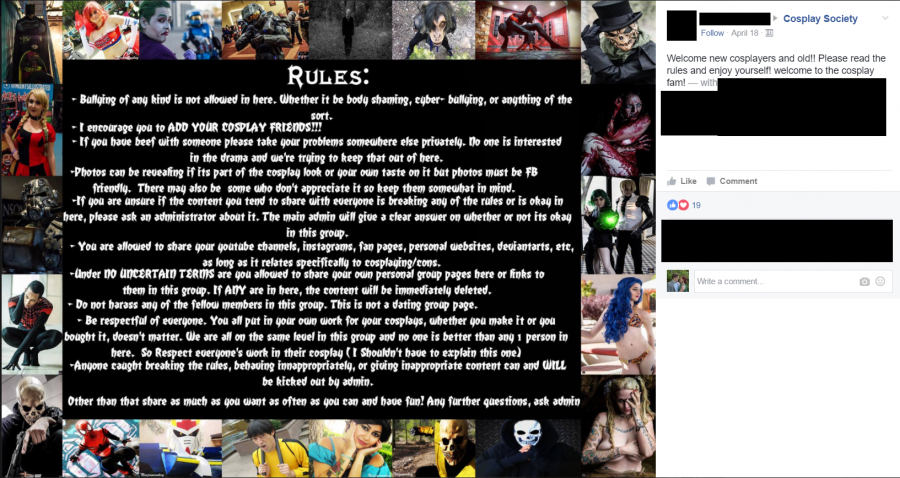
Figure 1: The rules in the group 'Cosplay Society' on Facebook
The group ‘Cosplay Society’ on Facebook is one of many online infrastructures for cosplayers and consists of 2717 members (according to data collected on 24-04-2017). The rules in this group, as can be seen in figure 1, reveal elements of the identity of the cosplayer. Cosplayers do not appreciate bullying and they value respect. They are usually characterized as friendly because of this. Cosplayers tend to compliment others regularly, both online and offline. It is custom to say something nice about each other’s cosplays, even if you do not truly like the cosplay the other is wearing. What also supports the claim that cosplayers are friendly is hugging. Whenever you run into another cosplayer, you give each other a hug. In the cosplay world there are even people who walk around with ‘free hugs’ signs at conventions (figure 2).
Figure 2: A cosplayer holding a 'Free Hugs' sign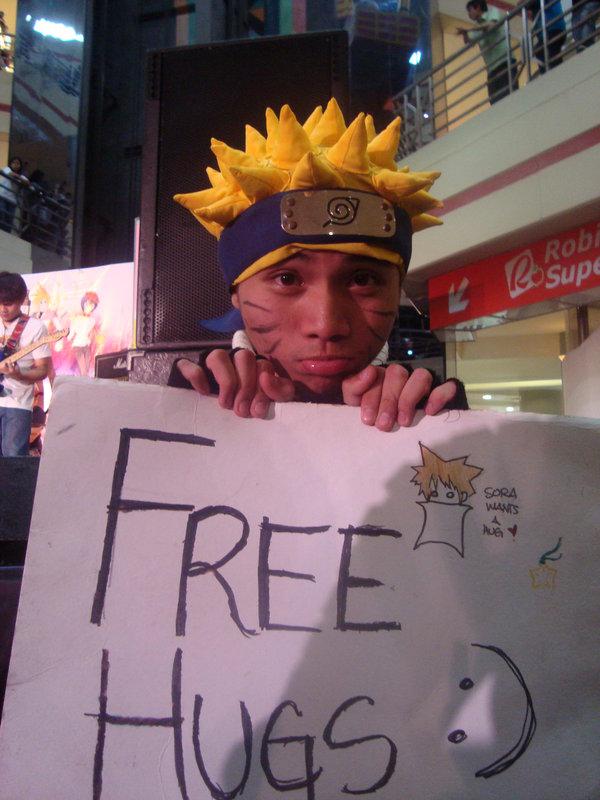
Cosplayers are often creative, since they usually make their own costumes. Cosplays can also be bought, but handmade cosplays are the norm (see the section 'cosplay norms'). In order to create cosplays you need certain skills. These skills can be picked up on- and offline. Online you can find lots of how-to videos and posts, which will help you in the process of creating cosplays. Online infrastructures also make it possible to ask for advice and opinions from professional cosplayers all over the world. Offline you can take sewing lessons and attend workshops at conventions to improve your skills. At Dynamiccon 2017, for example, I learned how to create armor and which materials I should use to do so.
Even though cosplayers can be described as fans, they do not necessarily have to be fans of the character they cosplay (Lamerichs, 2011). Sometimes they choose a cosplay because it is easy, or because they want to do a group cosplay. When I cosplayed Annie from League of Legends it was not because I adored her. Her outfit was an easy cosplay to start with and my friend, who was somewhat more experienced with cosplaying, knew much about the character. Cosplayers are thus fans, but they do not have to be a huge fan of the character itself in order to cosplay them.
Who is labeled as a cosplayer 'differs contextually depending on who uses the concept and in which part of the world' (Varis & Maly, 2015). It does seem like cosplayers all over the world share one identity, but in fact this is more complex. Cosplayers are not a homogenous phenomenon, but are actually polycentric and multi-layered.
Cosplay norms
Once you want to start cosplaying, you become part of the micro-population. The first thing to do is to pick a character. After that you start searching for other cosplays of that character and probably ask for advice from experienced cosplayers. As a newbie in this micro-population, you are not likely to create a magnificent cosplay right away. There are norms that determine whether a cosplay is good or bad.
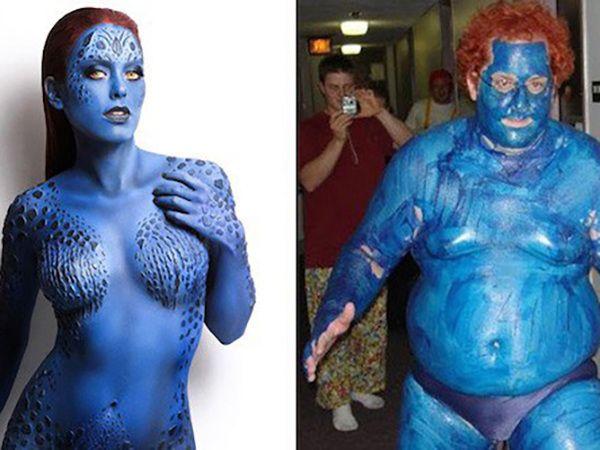
Figure 3: A bad cosplay
I entered ‘bad cosplay’ in Google Image search (figure 3), and it gives a clear idea of what a cosplay should not be. The most important thing about a cosplay is that you resemble the character. If others do not recognize the character you are trying to be, your cosplay has failed to meet the standards. The character you choose should thus fit the shape of your body.
Even though crossplay is accepted within the micro-population, it has to be well done. Crossplay is dressing up as a character of the other gender. An example of the phenomenon can be seen in figure 4 in which Fé wears a cosplay of Jack Frost. Fé is an authentic cosplayer who has won the second prize in a cosplay act competition. Her crossplay here is considered good, since she truly resembles the character. However, a cosplay can be considered bad if the crossplayer is not the right age and does not have the right body shape. If one ‘crossplays’ it is either really good or really bad.
Figure 4: An example of a crossplay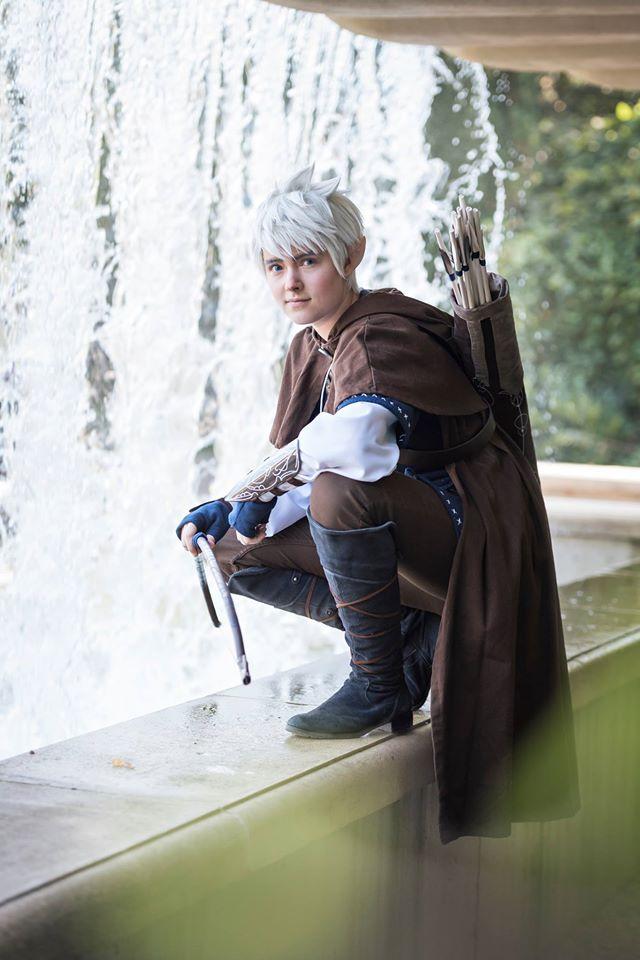
Another factor that makes or breaks a cosplay is quality. A cosplay that is made in a sloppy way from cheap materials is considered a failure. Sometimes the character being cosplayed is recognizable, but the costume is not executed properly. The quality is an important aspect in deciding whether the cosplay is approved of or not.
Cosplays do not have to be made by the cosplayer themselves. Although most cosplayers are creative, not all of them are. There is always a possibility to buy cosplays (most of the time from online shops). Bought cosplays are accepted if the cosplay is of good quality and resembles the character. However handmade costumes are better and more appreciated. The fact that you cannot enter cosplay competitions with bought cosplays (unless it is specifically mentioned that you can) shows that handmade costumes have a higher value in the micro-population.
An indication of a good cosplay is armor (figure 5). It is difficult to create and very impressive if well executed. When someone wears armor it is a sign that the cosplayer put a lot of effort into their cosplay. The cosplay is even better if it has a lot of detail.
Figure 5: Examples of cosplays that have armor and detail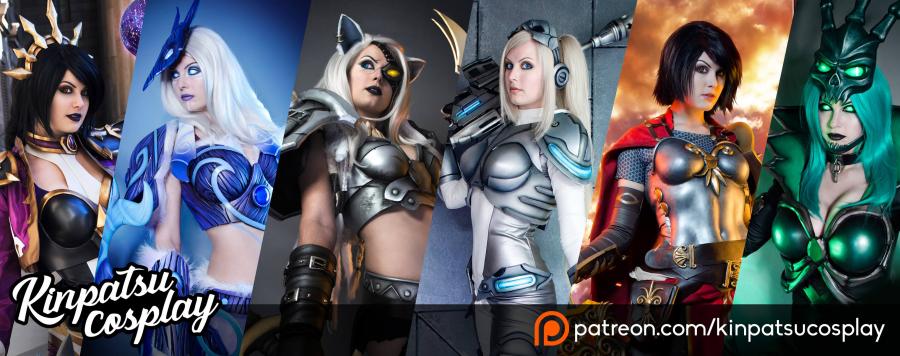
The novice and the master
As a newbie in the world of cosplay it can all be pretty overwhelming. It can be difficult to figure out where to start. Luckily there is always the possibility of asking a more experienced member of the micro-population what to do. I will analyze novices and masters in the cosplay world by using the theory Howard Becker (1997) provides us with in his book Outsiders.
Becker recognizes that a group exists of novices and masters. The master, of course, has been a part of the group for a longer period of time and is more familiar with the norms. The master can help the novice to integrate in the group. This divide between novice and master is also visible in the micro-population of cosplayers.
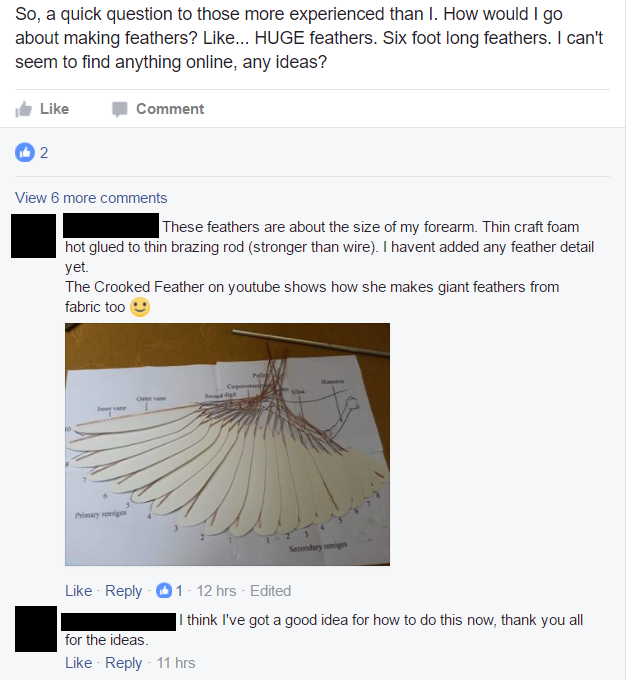
Figure 6: A novice asking for the help of masters
The masters in this particular micro-population have more knowledge about creating cosplays. They can give advice to newer members of the group (figure 6). The masters also play a key role in determining whether a cosplay is good or bad. Examples of this phenomenon are cosplay competitions. The judges are considered masters.
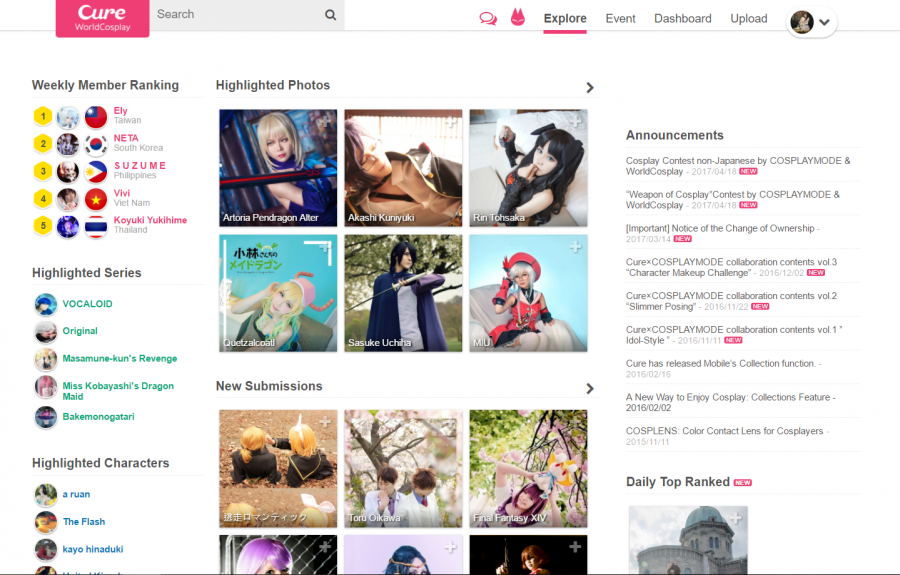
Figure 7: Worldcosplay.net
On worldcosplay.net (figure 7), a website purely designed for cosplayers all over the world, it is clear who the masters are. In the top left corner there is a ‘Weekly Member Ranking’, which shows the most popular members of the week. These members are experts and have become microcelebrities. A microcelebrity is ‘a state of being famous to a niche group of people’ (Marwick, 2013, as cited in Abidin, 2016). The microcelebrities set the tone and in fact determine the success rate of a cosplay. The fact that the number one in the Weekly Member Ranking has 17240 followers and 186299 likes (figure 8) proves that she has gained the status of master within the community. When I compare these numbers to my own (figure 8), you can see a clear difference. I would be considered a novice on worldcosplay.net.
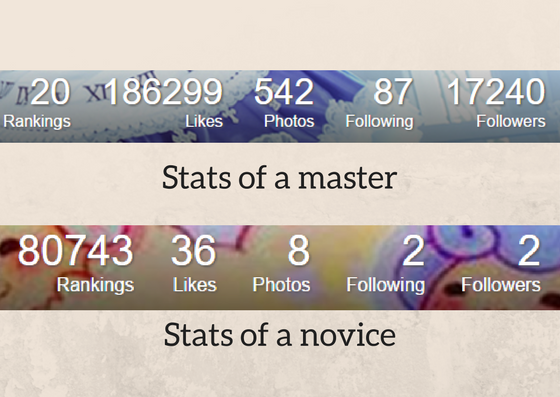
Figure 8: The difference of stats between a novice and a master
It is possible to rise in the cosplay world. This is what Becker (2015) calls 'career'. If one wants to become a master in creating cosplays, it will take lots of practice. At first you should learn how to create proper and realistic cosplays. I have already explained what defines a good cosplay in the previous section. Not only should your cosplay look good, you should also work on your act. If you want your cosplay to work you should actually be the character. A certain amount of knowledge is therefore required as well. To represent the character you should know the character; the habits, discourse, and personality. Once you master all these things and create several magnificent cosplays, (one great cosplay is not going to do the trick), you get closer to the label of master. Eventually one becomes a professional in dressing up and can actually make a living out of it.
Conventions and competitions
Next to the online infrastructures, there are also offline infrastructures that stimulate the cosplay micro-population. Even in a small country such as the Netherlands, there are around 18 conventions a year (Joyce, 2017). Conventions are the highlight of the year for most cosplayers. At conventions you can show off all the hard work you put in your outfit(s).
Conventions attract not only local cosplayers, but also cosplayers from all over the world. At most conventions signs are both in the native language and in English in order to make the con accessible to more nationalities. This is a clear sign that the cosplay micro-population acts on a transnational level.
At conventions it is customary to wear a cosplay. People actually stand out if they do not wear one. I have seen cosplayers bring multiple cosplays with them, so they can change at any time. This way they can show more than one cosplay to others.
Figure 9: Cosplay photoshoot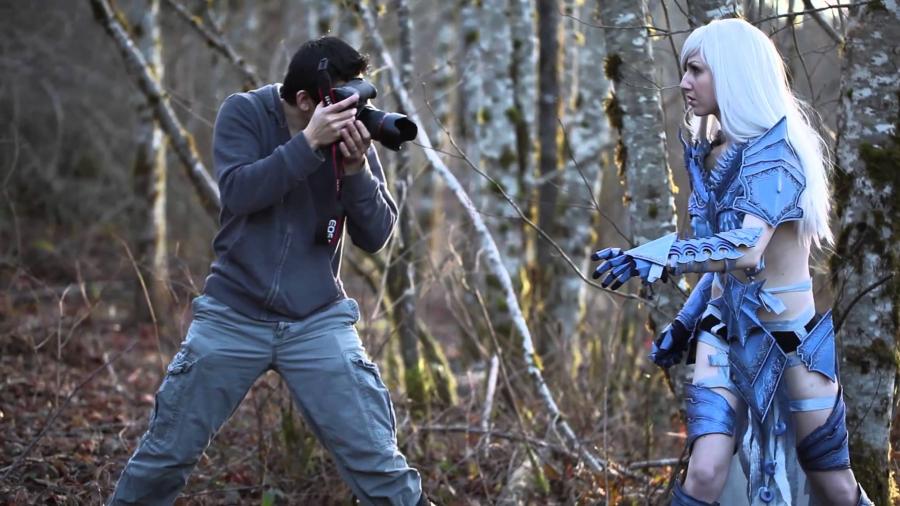
Multiple cosplays are also important due to photoshoots. As a cosplayer it is of importance to do photoshoots. Through photoshoots you can capture your cosplays and then show them to an even bigger audience (figure 9). A link can be made here between the online and offline. The pictures taken at photoshoots are often shared on social media and websites such as worldcosplay.net. Due to this one can gain more fame on- and offline and reach the status of a master (Becker, 1997) or a microcelebrity.
There are different kinds of cosplay competitions at conventions. Some competitions focus purely on the cosplay itself, but there are also cosplay act competitions. As I mentioned before, the performance is also an important element of cosplay (Lamerichs, 2011). These competitions are judged by experts in the field of cosplay, i.e. masters. I attended a workshop on cosplay act competitions and learned that you cannot ‘just join’. There are some very strict rules, and if you want a shot at winning it takes months of practice. In figure 10 shows what is needed in order to sign up for the cosplay act competition at Abunai!

Figure 10: What you need in order to sign up for the cosplay act competition at Abunai!
Cosplaying as a highly diverse activity
This micro-population has changed throughout the years due to the emergence of the Web 2.0. The Internet enables cosplayers to communicate with each other through online platforms. Cosplaying is ‘a highly diverse activity’ (Lamerichs, 2011), as can be seen in the previous sections. Cosplaying does not only involve a costume, but also a performance. In order to create a good cosplay you will need to be the character you are trying to represent.
Within the micro-population there are novices and masters (Becker, 1997). One can change from a novice to a master by gaining certain knowledge, skills, fame and creating multiple successful cosplays. In order to truly be part of the micro-population you will have to engage in an on- as well as offline environment.
References
Albidin, C. (2016, April 11). "Aren't These Just Young, Rich Women Doing Vain Things Online?": Influencer Selfies as Subversive Frivolity. Social Media Society.
Becker, H. (1997). Outsiders: Studies in the Sociology of Deviance. Free Press.
Joyce. (2017). Anime en cosplay conventies in Nederland 2017. http://www.thesushitimes.com.
Lamerichs, N. (2011). Stranger than fiction: Fan identity in cosplay. Transformative Works and Cultures, 7.
MacWilliams, M. (2014). Japanese Visual Culture: Explorations in the World of Manga and Anime. Routledge.
Maly, I. (2016). Saabism and Saabists. A digital ethnographic analysis of Saab culture. Journal of consumer culture.
pachmoedius. (2005). Urban Dictionary.
Pink, S., Horst, H., Postill, J., Hjorth, L., Lewis, T., & Tacchi, J. (2015). Digital Ethnography: Principles and Practice. SAGE publications.
Varis, P. (2014). Digital Ethnography.
Varis, P., & Maly, I. (2015). The 21st-century hipster: On micro-populations in times of superdiversity. European Journal of Culture Studies, 1-17.